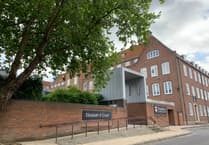PARENTS have called for a tightening up of the sibling rule at high-performing Weydon School.
A Freedom of Information request revealed siblings of existing pupils living as far as 10 miles away were awarded places in this academic year – ahead of many children who live close to the school.
Weydon’s published admission number (PAN) for 2018 was 308.
However, 330 children were offered places. Of these, 163 children qualified under the sibling rule, as set out in the school’s admissions criteria.
The school policy is: “Places are offered to siblings of students who will be attending the school at the time of the admission.”
A total of 159 pupils were offered places from its feeder schools – Highfield South Farnham Primary, Potter’s Gate Primary, Rowledge Primary, South Farnham Primary, St Peter’s Primary and Waverley Abbey Junior School.
The FOI request, submitted by the Herald, revealed that on the national offer day of March 1, 2018, “of those pupils who were offered a place under the sibling rule at Weydon School, the furthest distance was 17.396km”.
That equates to 10.8 miles. – roughly the equivalent of a student attending from as far as Liphook, Hook, Milford, Farnborough or Wanborough.
In a letter to the Herald, Anne Houston, whose daughter currently attends one of Weydon’s feeder schools, writes: “All new children had to be within 2km but a sibling could live miles and miles away.
“How does this help Farnham’s traffic, pollution or the cohesion of the local community?
“How do you explain that to your child when all his friends are going on to Weydon and he’s packed off miles away to a different school, even though he could’ve walked to a school down the road?
“Traditionally, Weydon also serves our nearest villages; but those in Rowledge, Crondall, Tilford, Frensham and Dockenfield had no hope at all of getting into Weydon. This was even the case for some areas of the Bourne.”
Anne says priority should be given to families living close to the school – and that if they move away from the catchment area, they should lose their priority status.
“If you want to move house, that’s absolutely fine,” she writes.
“You know where you stand and if you want your other children to go to the same school then move nearby, or don’t move until the last child is in.
“Clearly, there would be nothing stopping someone moving to Timbuktu once all their kids are safely in a school but the message is clear – commit to the area long term or lose your place to those who will.”
A spokesperson for Weydon School said: “Our admissions policy does not have a catchment area, so therefore each year our radius of home addresses of first-born students who attend one of our partner schools (over-subscription criteria number five) will vary according to local demographic changes.
“Sibling numbers for the September 2018 intake was higher than previous years.
“However, early indication for the September 2019 intake is this peak in numbers will not be replicated.
“As part of its 2020 admissions policy review, the school conducted a data collection exercise with its partner primary schools to establish, to the best of its knowledge, what the sibling profile may look like in years to come.
“The school has taken these findings into account when drafting its 2020 admissions policy for consultation.
“However, local demographic changes are not something the school can control, or accurately predict, and therefore all these figure are in a constant state of flux.
“The rationale for the sibling criteria is that, as a trust, we believe families should be able to send their children to the same school.
“This gives equality of opportunity, ease of costs to families in respect of uniform, convenience for travel arrangements getting to and from school and for after-school opportunities, no clashes of school diaries and building a sense of community.
“We finished our formal admissions policy consultation on December 21, 2018.
“This was the forum for anyone who wished to make any comments on our 2020 admissions policy and all these comments have been forwarded to the governors’ Admissions Committee for reflection.”
They continued that ensuring there was enough local school places for local children “is the responsibility of the local authority”, but that one of the proposed changes was to increase its PAN from 308 to 330.
n What do you think? Is it right that brothers and sisters should go to the same school – or should admission be based on a family’s address? Let us know by e-mailing [email protected].





Comments
This article has no comments yet. Be the first to leave a comment.